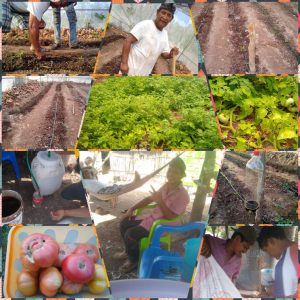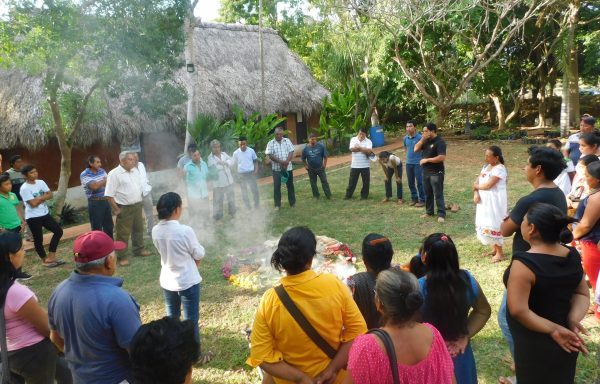First published on 05/15/2020, and last updated on 05/29/2020
By the Ka’Kuxtal Much Meyaj team, ICCA Consortium Member.
In Mexico, our Member Ka’Kuxtal and the Mayan communities with whom they work are promoting responses to the current crisis, in the areas of health, food sovereignty and communication, to take the care for their people into their own hands.
Ka’Kuxtal Much Meyaj (Ka´Kuxtal) is a Mayan organization, Member of the ICCA Consortium since 2018. We are located in the municipality of Hopelchén, Campeche, in south-eastern Mexico, better known as the Chenes Region, named this way due to its peculiar characteristic: ch’een means ‘well’ in the Mayan language, and the name of Hopelchén translates as the “place of the five wells”.
Keep our corn alive
In Hopelchén there are 40,100 inhabitants and only one second-level General Hospital that attends the entire Mayan and Mennonite population in the region. Due to the characteristics of the hospital, serious cases are transferred to the state capital, which is an hour away by road. Some Mayan communities have health centres, which in the best of cases have their own premises, the doctor arrives once every fortnight and only has the very basic of medicines.
In addition to the above, for the past 30 years or so, in Hopelchén we have lived with a constant threat to our native seeds, our forests and our Mayan ways of life; first by the introduction of hybrid seeds and “technology packages” that promised many benefits in terms of production yield using large amounts of agrochemicals and destroying the forest, and then with the introduction of genetically-modified soybean crops.
This has caused communities to gradually abandon traditional food production practices and, consequently, an increase in the consumption of processed food. This results in the state of Campeche having the second highest obesity rate in Mexico, in addition to related diseases: diabetes, hypertension, heart disease or cancer.
However, on the other hand, the Mayan communities with a strong cultural identity are motivated to keep alive our corn varieties and the different foods we get from the milpa (the cultivation of native corn along with beekeeping and caring for the forest was our vocation in this region, before the arrival of industrial agriculture).

Agroecology © Jesus Rueda Ka_Kuxtal
Difficulties of access to health services
As an indigenous organization, we hold assemblies constantly to reflect and make decisions regarding the problems in the municipality. Our work mainly focuses on the conservation of seeds and defending our territory, which means we are constantly analysing the situation in the region. This is how we know the precarious conditions of health care. Despite the great efforts of doctors and nurses to give the necessary care, the structural conditions and the limited availability of supplies and materials result in this contradiction: although health is a right, our peoples still do not see it guaranteed in these times.
Prepare as a community in view of COVID-19
It was due to this situation that we took it upon ourselves to prepare and put into writing a series of recommendations for our brothers and sisters in the communities: and so was borne the Community COVID-19 Contingency Protocol. We knew that we could not stop the contamination from spreading, but we could prepare for when it actually reaches our communities.
 The Community COVID-19 Contingency Protocol is the result of our reflections within Ka´Kuxtal. After the declaration of the pandemic and after actions were taken at the national and state levels, several weeks went by without any information destined for the Mayan people. At the national level, a series of protocols began to be publicized in different media in the beginning of April, but none of them addressed Indigenous peoples.
The Community COVID-19 Contingency Protocol is the result of our reflections within Ka´Kuxtal. After the declaration of the pandemic and after actions were taken at the national and state levels, several weeks went by without any information destined for the Mayan people. At the national level, a series of protocols began to be publicized in different media in the beginning of April, but none of them addressed Indigenous peoples.
Our concern focused on caring for our people and above all being alert in the contingency. The Protocol was the way we delivered to the communities the information about the magnitude of the threat and the level of organization required to face it, as our awareness of our vulnerability required clearly identifying the magnitude of the problem, and this was important to communicate.
Take our own care as Peoples into our own hands
At the same time, it was a call to our people to take our own care into our own hands, given that the national states have done so little for our people. The fact that still, after so many centuries, we continue recreating our culture depends fundamentally on the efforts that our ancestors made to keep our people alive. This time, it is up to all of us in this generation to keep our people healthy, and to keep alive the memory of our grandparents.
In March, some situations that required attention were already present in the region: the return of the migrant Indigenous population from the tourist area known as the Mayan Riviera, the suspension of economic activities, false and real rumours about the impacts of the virus and information from other countries through social media networks, etc.
Community organization to face the emergency
Given all of the above, the first task was to collect and analyse information about the virus, the characteristics of the disease, its high contagion level, previous experiences in risk management and contingency care. Then, we dedicated ourselves to promoting community organization in the eventual arrival of COVID-19 in the region.

Informational poster © Selena Uc Ka_Kuxtal.
The community organization suggested in the Protocol consists of 4 elements:
- Identification of the basic needs of the community regarding health, water, food, etc .;
- Activation of the internal organization for contingency monitoring;
- Recommendations for the care of the population at risk; and
- Recommendations for the care of the infected population.
Finally, a mapping of the conditions and characteristics of each community was also proposed, to identify the most vulnerable members of the population.
In the context of the pandemic, community decisions continue to be taken in assemblies, within the recommended measures of safe distance, and in recent weeks also making use of mouth coverings. In addition, social media and apps are used to communicate, and although these are mainly used by the youth, they channel the information towards the elders as well.
Generate reliable information to and from communities
Due to the amount of confusing information that came to Hopelchén all at the same time, we decided to implement a series of strategies related to communication and information, which we implemented through the members of the organization, especially young people, who are in different communities of the municipality and who could use virtual social networks despite the precarious internet system.
These were our first actions as a response to the contingency: we focused on generating information towards the communities and also making the feelings, thoughts and reflections of the communities known towards the outside world. For this purpose, we created an informative Facebook page “Ka’Kuxtal Informa” since Facebook is a widely used means of communication by the young people in the region.
Secure planting and support the economy of our communities
We have conducted interviews with community authorities, women, youth, boys and girls, all of them regarding the disease. We have also connected with medical personnel who have promptly clarified doubts and expanded the information. We developed a medicinal plant manual to strengthen the immune and respiratory systems. And we are currently working on securing the seeds for planting and the exchange of milpa garden products and crafts, to ensure food and support the economy of our communities.

Festival of native seeds before the crisis © Ka’Kuxtal
In this way, the recovery of food sovereignty, the food we can count on from the milpa and our plots, as well as our territorial governance and the exercise of our right to health in practice, become pillars to face this pandemic, as communities and as an indigenous organization.
Download here the Community COVID-19 Contingency Protocol.
Featured image: Ka’Kuxtal Regional Meeting before the crisis © Ka’Kuxtal.
Translation from Spanish: Vanessa Linforth.
